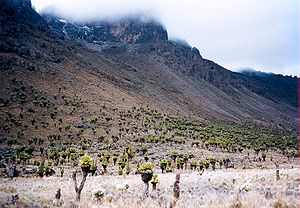Mount Kenya National Park: Difference between revisions
m →External links: remove obsolete stub template - start class now |
No edit summary Tag: repeating characters |
||
| Line 1: | Line 1: | ||
{{Infobox World Heritage Site |
helloooooooo{{Infobox World Heritage Site |
||
| WHS = Mount Kenya National Park/Natural Forest |
| WHS = Mount Kenya National Park/Natural Forest |
||
| Image = [[Image:MtKenyaMackinder.jpg|300px]] |
| Image = [[Image:MtKenyaMackinder.jpg|300px]] |
||
Revision as of 08:09, 5 July 2011
helloooooooo
| UNESCO World Heritage Site | |
|---|---|
 | |
| Criteria | Natural: vii, ix |
| Reference | 800 |
| Inscription | 1997 (21st Session) |
Mount Kenya National Park, established in 1949, protects the region surrounding Mount Kenya. Initially it was a forest reserve before being announced as a national park. Currently the national park is within the forest reserve which encircles it.[1] In April 1978 the area was designated a UNESCO Biosphere Reserve.[2] The national park and the forest reserve, combined, became a UNESCO World Heritage Site in 1997.[3]
The Government of Kenya had four reasons for creating a national park on and around Mount Kenya. These were the importance of tourism for the local and national economies, to preserve an area of great scenic beauty, to conserve the biodiversity within the park, and to preserve the water catchment for the surrounding area.[4]
The national park has an area of 715 square kilometres (276 sq mi), most of which is above the 3,000 metres (9,800 ft) contour line.[2][4] The forest reserve has an area of 705 square kilometres (272 sq mi). Combined this makes the area of the UNESCO World Heritage Site 1,420 square kilometres (548 sq mi).[2]
A small portion of this park's borders near heavy populations have electrified fences to keep the elephants out of the surrounding farmland.[5] Volcanic sediment in the surrounding region's soil and the huge volume of fresh water coming down the slopes makes the area particularly favourable for agriculture.[6]
At lower altitudes Colobus and other monkeys and Cape Buffalo are prevalent.
References
- ^ Kenya Wildlife Service. "Mount Kenya National Park". Retrieved 2011-02-23. [dead link]
- ^ a b c United Nations Environment Programme (1998). "Protected Areas and World Heritage". Archived from the original on 2007-02-12. Retrieved 2008-02-23.
- ^ United Nations (2008). "Mount Kenya National Park/Natural Forest". Archived from the original on 2006-12-30. Retrieved 2008-02-23.
- ^ a b Gichuki, Francis Ndegwa (1999). "Threats and Opportunities for Mountain Area Development in Kenya" (subscription required). Ambio. 28 (5). Royal Swedish Academy of Sciences: 430–435.
{{cite journal}}: Cite has empty unknown parameter:|coauthors=(help); Unknown parameter|month=ignored (help) - ^ Ojany, Francis (1993). "Mount Kenya and its Environs: A review of the interaction between mountain and people in an equatorial setting". Mountain Research and Development. 13 (3). International Mountain Society: 305–309. doi:10.2307/3673659. JSTOR 3673659.
{{cite journal}}:|access-date=requires|url=(help); Unknown parameter|month=ignored (help) - ^ Speck, Heinrich (1982). "Soils of the Mount Kenya Area: Their formation, ecology, and agricultural significance". Mountain Research and Development. 2 (2). International Mountain Society: 201–221. doi:10.2307/3672965. JSTOR 3672965.
{{cite journal}}: Cite has empty unknown parameter:|coauthors=(help)
